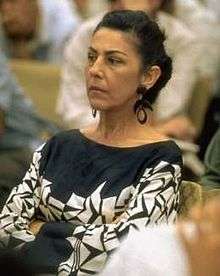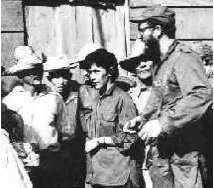Celia Sánchez
| Celia Sanchez | |
|---|---|
 | |
| Born |
May 9, 1920 Media Luna, Cuba |
| Died |
January 11, 1980 (aged 59) Cuba |
Celia Sánchez Manduley (May 8, 1920–January 11, 1980) was a Cuban revolutionary, politician, researcher and archivist. She was a close friend of Fidel Castro.[1]
Biography
Early life

Sánchez was born in Media Luna,[2]:681 Oriente, Cuba.
Cuban revolution
Sánchez joined the struggle against the Batista government following the coup of March 10, 1952. She was the founder of the 26th of July Movement in Manzanillo.[2]:681 Together with Frank País, she was one of the first women to assemble a combat squad during the revolution.[3] She made the necessary arrangements throughout the southwest coast region of Cuba for the Granma landing, and was responsible for organising reinforcements once the revolutionaries landed.[2]:682 In 1957, she joined the guerrillas and served as messenger. Celia placed small telegrams inside a Butterfly flower, so the messages would remain secret. As a member of the general staff of the Rebel Army she supplied Che Guevara and other rebels with weapons, occasionally food and medical supplies.[4]
Post-revolution years
During the mid to late 1960s, René Vallejo, Castro's physician since 1958,[5] and Sanchez became the Cuban leader's two closest companions.[5] Sánchez was bestowed with the title of Secretary to the Presidency of the Council of Ministers[6] and served in the Department of Services of the Council of State until her death of lung cancer in 1980.[5]
She archived many documents, letters and notes of the revolution, leading to the creation in 1964 of Oficina de Asuntos Históricos del Consejo de Estado, an institution for the preservation of historical documents.[7]
Death
Celia Sánchez died on 11 January 1980 during a time of political and economic unrest, but her legacy is embedded in the Cuban national identity.[8]
Legacy
Following the death of Celia Sánchez, Fidel Castro commemorated her life by proclaiming her symbolism to the Revolution.[8] Castro stated in a speech outside of Hospital of Celia Sanchez Manduley dedicated to Celia Sanchez,
I truly believe that this is the best form of tribute to pay to someone who dedicated herself to duty, without resting for a moment, without forgetting one single detail; and I believe, sincerely, that this is the most heartfelt, profound and revolutionary homage that one can give to a compatriot who gave her life for the Revolution.
—Fidel Castro on Sánchez[9]
Cubans commemorate her life due to her crucial role in the revolution by putting her name on schools, hospitals, and various community centers, from Cuba to Zimbabwe.[10] Matter of fact, people of Manzanillo commonly use the altar of the Caridad del Cobra Virgin as a marriage altar signifying the dedication of Celia Sánchez to the Cuban Revolution.[10] The monument is as if Celia Sánchez is wearing a dress, stiff and enormous, like the jeweled dress worn by the Caridad Virgin.[10]
A memorial to and mausoleum for Celia Sanchez was built in Parque Lenin. However, As of November 2014 the remains of Celia Sanchez are interred in the Colon Cemetery, Havana. The Celia Sánchez Memorial in Manzanillo also honors her name, and her face appears in the watermark on Cuban peso banknotes.
Furthermore, Celia’s memory has had a large impact far beyond the remembrance of one woman in the Cuban Revolution but rather encompasses the standards of the new Cuban national identity.[8] Celia Sánchez paved the way for the idealism for Cuba's new woman by showing women's capabilities in the leadership, care taking and physical labor.[8] Simplicity, modesty, femininity, selflessness, austerity and devotion are some of they key attributes of Celia Sánchez; however, these personal virtues represent much more than references to a deceased individual, but rather represents the embodiment of Cuba's new woman.[8] Celia Sánchez revealed to the Cuban society that women are capable of balancing physical labor with care taking, strength with femininity and leadership with modesty which was a nuance during a time of gender division.[8]
See also
References
- Notes
- ↑ Pressly, Linda (December 11, 2011). "BBC News - Celia Sanchez: Was she Castro's lover?". Bbc.co.uk. Retrieved December 11, 2011.
- 1 2 3 Ramonet, Ignacio, Fidel Castro: My Life. Penguin Books: 2007.
- ↑ Celia Sánchez, pg.76 by Richard Haney, John Van Houten Dippel, Algora, 2005
- ↑ Guevara, Ernesto, "Reminiscences of the Cuban Revolutionary War", p.312, Harper Perennial, 2006
- 1 2 3 The Socialist Register 1989, NOTES ON THE CUBAN REVOLUTION, Saul Landau, pg. 296
- ↑ Fidel Castro, leader of communist Cuba, pg. 53, Compass Point Books, 2006
- ↑ Saborit Alfonso, Amaya. "Celia Sánchez Manduley: se equivoca la muerte...". Granma. Retrieved 2014-12-30.
- 1 2 3 4 5 6 Thomas-Woodard, Tiffany A. (2003). "Towards the Gates of Eternity: Celia Sanchez Manduley and the Creation of Cuba's New Woman". Project Muse. University of Pittsburgh Press. Retrieved November 15, 2016.
- ↑ Castro, Fidel (January 16, 1981). "Fidel en la inauguración del Hospital Celia Sánchez Manduley". Project Muse. University of Pittsburgh Press. Retrieved 26 November 2016.
- 1 2 3 Stout, Nancy (2013). One Day in December: Celia Sánchez and the Cuban Revolution. New York: Monthly Review Press. pp. 440, 441. ISBN 978-1583673171 – via JSTOR.
In the years following Celia’s death, special medals and commemorative stamps were issued with her image; her portrait is the watermark on several pieces of the country’s currency; a Spanish ballet was named for her; her name is on schools, hospitals, and various community centers, from Cuba to Zimbabwe." "People of Manzanillo commonly use the monument as a marriage altar.
External links
| Wikimedia Commons has media related to Celia Sánchez. |
- Celia Sánchez at EcuRed
- Review of "One Day in December: Celia Sánchez and the Cuban Revolution" at Socialism and Democracy Online
- General overview of women in the Cuban Revolution at JSTOR